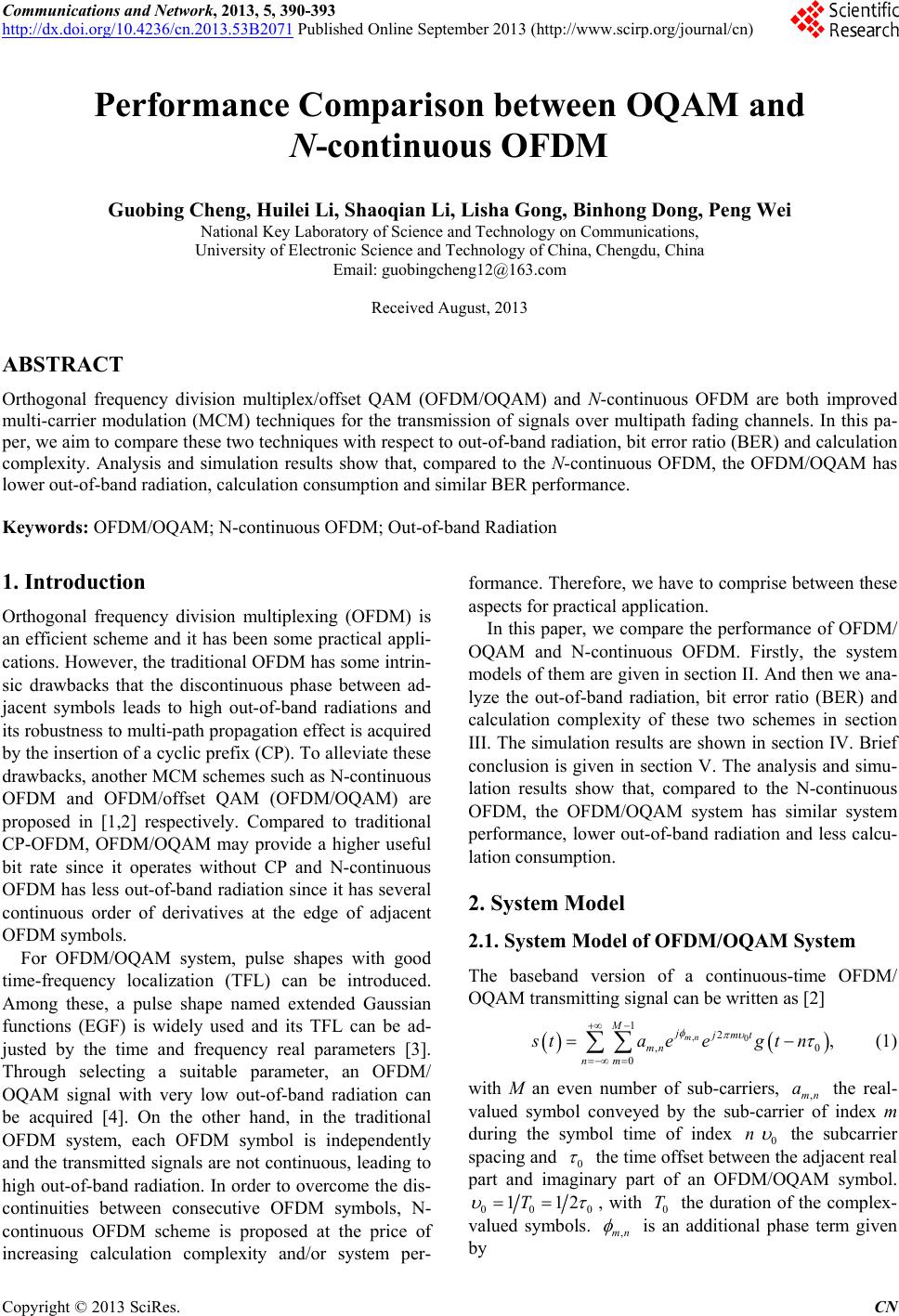
Communications and Network, 2013, 5, 390-393
http://dx.doi.org/10.4236/cn.2013.53B2071 Published Online September 2013 (http://www.scirp.org/journal/cn)
Performance Comparison between OQAM and
N-continuous OFDM
Guobing Cheng, Huilei Li, Shaoqian Li, Lisha Gong, Binhong Dong, Peng Wei
National Key Laboratory of Science and Technology on Communications,
University of Electronic Science and Technology of China, Chengdu, China
Email: guobingcheng12@163.com
Received August, 2013
ABSTRACT
Orthogonal frequency division multiplex/offset QAM (OFDM/OQAM) and N-continuous OFDM are both improved
multi-carrier modulation (MCM) techniques for the transmission of signals over multipath fading channels. In this pa-
per, we aim to compare these two techniques with respect to out-of-band radiation , bit error ratio (BER) and calcu lation
complexity. Analysis and simulation results show that, compared to the N-continuous OFDM, the OFDM/OQAM has
lower out-of-band radiation, calculation consumption and similar BER performance.
Keywords: OFDM/OQAM; N-continuous OFDM; Out-of-band Radiation
1. Introduction
Orthogonal frequency division multiplexing (OFDM) is
an efficient scheme and it has been some practical appli-
cations. However, the trad itional OFDM has some intrin-
sic drawbacks that the discontinuous phase between ad-
jacent symbols leads to high out-of-band radiations and
its robustness to multi-path propagation effect is acquired
by the insertion of a cyclic prefix (CP). To alleviate these
drawbacks, another MCM schemes such as N-continuous
OFDM and OFDM/offset QAM (OFDM/OQAM) are
proposed in [1,2] respectively. Compared to traditional
CP-OFDM, OFDM/OQAM may provide a higher useful
bit rate since it operates without CP and N-continuous
OFDM has less out-of-band radiation since it has several
continuous order of derivatives at the edge of adjacent
OFDM symbols.
For OFDM/OQAM system, pulse shapes with good
time-frequency localization (TFL) can be introduced.
Among these, a pulse shape named extended Gaussian
functions (EGF) is widely used and its TFL can be ad-
justed by the time and frequency real parameters [3].
Through selecting a suitable parameter, an OFDM/
OQAM signal with very low out-of-band radiation can
be acquired [4]. On the other hand, in the traditional
OFDM system, each OFDM symbol is independently
and the transmitted signals are no t continuous, leading to
high out-of-band radiation. In order to overcome the dis-
continuities between consecutive OFDM symbols, N-
continuous OFDM scheme is proposed at the price of
increasing calculation complexity and/or system per-
formance. Therefore, we have to comprise between these
aspects for practical application.
In this paper, we compare the performance of OFDM/
OQAM and N-continuous OFDM. Firstly, the system
models of them are given in section II. And then we ana-
lyze the out-of-band radiation, bit error ratio (BER) and
calculation complexity of these two schemes in section
III. The simulation results are shown in section IV. Brief
conclusion is given in section V. The analysis and simu-
lation results show that, compared to the N-continuous
OFDM, the OFDM/OQAM system has similar system
performance, lower out-of-band radiation and less calcu-
lation consumption.
2. System Model
2.1. System Model of OFDM/OQAM System
The baseband version of a continuous-time OFDM/
OQAM transmitting signal can be written as [2]
,0
12
,0
0,
mn
Mjjmt
mn
nm
staeegt n
(1)
with M an even number of sub-carriers, ,mn the real-
valued symbol conveyed by the sub-carrier of index m
during the symbol time of index n0
a
the subcarrier
spacing and 0
the time offset between the adjacent real
part and imaginary part of an OFDM/OQAM symbol.
00 0
1 2T1
, with 0 the duration of the complex-
valued symbols. T
,mn
is an additional phase term given
by
C
opyright © 2013 SciRes. CN